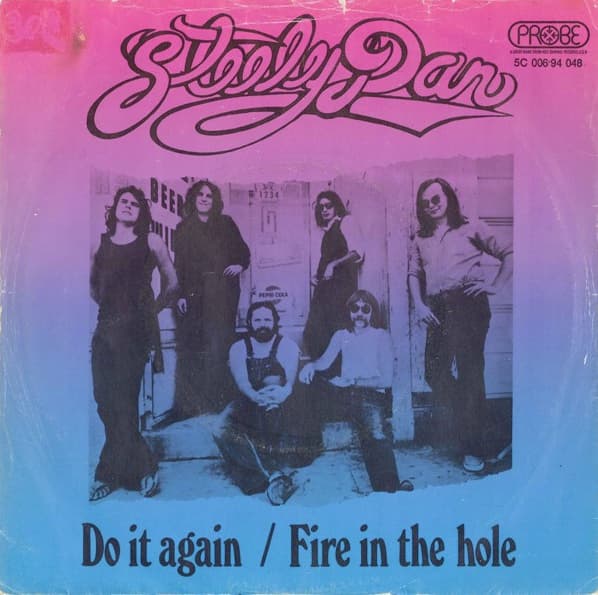
Steely Dan – “Do It Again”: A Slick, Cynical Exploration of Repetition and Fate
Steely Dan’s “Do It Again” is a hypnotic, jazz-rock track that explores themes of fate, vice, and the inevitability of repeating one’s mistakes. Released in 1972 on their debut album Can’t Buy a Thrill, the song became a major hit, reaching No. 6 on the Billboard Hot 100. Written by Donald Fagen and Walter Becker, “Do It Again” stands out for its complex lyrics, intricate instrumentation, and fusion of rock, jazz, and Latin rhythms, which create a distinctive sound that would become Steely Dan’s signature style.
The song opens with a percussive, Latin-inspired groove, featuring a distinct bongo rhythm and a snaking electric sitar riff that immediately sets a mysterious, almost hypnotic mood. This rhythm creates a feeling of cyclical movement, mirroring the song’s theme of life’s inevitable cycles. The instrumentation is layered and smooth, featuring electric piano, guitar, and bass, each element working in harmony to create a complex, sophisticated sound. This rhythmic foundation provides a steady, pulsing beat that draws the listener into the song’s world of moral ambiguity and recurring mistakes.
Lyrically, “Do It Again” tells the stories of several characters who are trapped in patterns of self-destructive behavior. Each verse introduces a different scenario—someone caught in a crime of passion, another involved in gambling, and yet another consumed by vengeance. The line “You go back, Jack, do it again” captures the song’s essence, suggesting that these characters are doomed to repeat their mistakes, unable to break free from their cycles of behavior. The lyrics reflect Steely Dan’s characteristic cynicism and dark humor, presenting these situations with a detached yet insightful perspective.
The chorus, “You go back, Jack, do it again,” is both catchy and unsettling, emphasizing the inevitability of repeating one’s actions. This refrain has a hypnotic quality, reinforcing the song’s theme of circular motion and fate. It suggests a kind of resignation, as though these patterns are inescapable, no matter how hard one might try to change. The repetition of the chorus gives the song a trance-like feel, pulling listeners deeper into the sense of being caught in a loop.
Donald Fagen’s vocal delivery is cool and detached, adding a layer of irony to the song. His voice is smooth but filled with a hint of disdain, as though he’s observing these characters from a distance and acknowledging their flawed nature. Fagen’s delivery, with its slightly sardonic tone, enhances the song’s message of cynicism and inevitability. His vocal style makes the lyrics feel less like a warning and more like an acceptance of human nature’s darker tendencies.
The musical arrangement in “Do It Again” is a fusion of rock, jazz, and Latin influences, with an emphasis on rhythm and groove. The electric sitar riff, played by guitarist Denny Dias, gives the song an exotic, psychedelic feel, while the electric piano and bass add a smooth, jazzy texture. This blend of sounds creates a unique atmosphere that feels both sophisticated and unsettling, perfectly matching the song’s theme of moral ambiguity. The song’s extended instrumental breaks showcase Steely Dan’s technical skill and flair for complex arrangements, making it a track that rewards repeated listening.
Since its release, “Do It Again” has become one of Steely Dan’s most iconic songs, celebrated for its intricate musicianship and thought-provoking lyrics. The song’s exploration of human nature, temptation, and the struggle to break free from harmful patterns has resonated with listeners for decades. Its complex sound and darkly humorous lyrics have made it a favorite among fans of jazz-rock and those who appreciate music that combines depth with sophistication.
“Do It Again” remains relevant for its portrayal of life’s cyclical nature and the difficulty of escaping one’s flaws. The song’s hypnotic beat and catchy chorus continue to captivate audiences, making it a timeless track that speaks to anyone who has ever felt trapped by their own choices.
In the end, “Do It Again” is more than just a song about vice—it’s a reflection on the patterns that define our lives and the challenge of breaking free from them. Steely Dan’s smooth yet cynical delivery, combined with the song’s intricate arrangement and memorable rhythm, creates a track that is as engaging as it is thought-provoking. For fans of jazz-rock and anyone who has experienced the allure and frustration of repeating the same mistakes, “Do It Again” is a classic that remains as compelling today as it was when it first hit the charts.